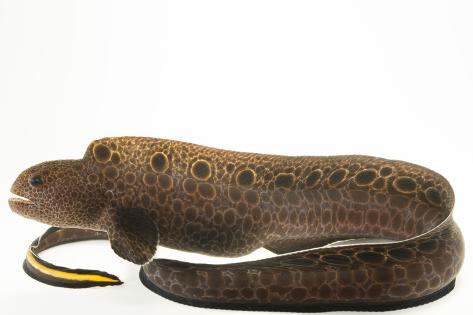
Once a pair of wolf eels finds a suitable den, they will make that their permanent home, unless they are driven out by a bigger wolf eel or an octopus. They tend to stick their head out of their dens and wait for their prey. DISTRIBUTION/HABITAT Sea of Japan and Aleutian Islands to Imperial. The slender body of the wolf eel helps it to settle in such narrow spaces. Not a true eel of the Order Anguilliformes. Wolf eels are particularly fond of living in small cracks and crevices and often end up competing with octopuses who also have the same habitat. However, once they become adults, they settle down in dens, pilings, and rocky reefs. Juvenile wolf eels mostly spend their time in open waters. Larvae mainly rely on plankton as food until they are old enough to eat mussels and crabs. These creatures have sharp teeth in their jaws which help them in these crushing hard-shelled marine animals. They mainly feed on clams, sea urchins, mussels, crabs, and smaller fish. When compared to the green wolf eel, which has a length of 1 ft 6 in (45.7 cm), wolf eels are nearly eight times longer!Īdult wolf eels are carnivorous in nature.

These creatures have quite a long and slender body. Some are measured at 8.2 ft (2.5 m), as well. The length of the body of a wolf eel can be up to 8 ft (2.4 m). Overall, wolf eels look pretty scary and ferocious, which aids them in scaring off predators. The jaws in these creatures are provided with sharp teeth. This bottom dwelling fish is common along rocky shorelines and areas with large boulders which form.

Size: up to 240cm (94in), 18.4kg (40.6lb) Distribution: Eastern Aleutian Islands to southern California Sea of Okhotsk and the Sea of Japan. Interestingly, Wolf Eels are monogamous, and pairs will share a den and protect their eggs together. They hunt mollusks, shellfish, and crustaceans by waiting for the critters to wander by. They live in rocky crevasses, leaving only their heads exposed. They also have a much more wrinkled face when compared to a female (which is why some people argue that male wolf eels are uglier fish than females and that wolf eel females are not ugly fish) Male and female wolf eels also differ in color, as the former has a lighter body color. Scientific Name: Anarrhichthys ocellatus. Wolf Eels live in relatively shallow water, typically no deeper than around 700ft (213m). Adult males are especially known to have bulging heads and prominent lips. Dorsal soft rays (total): 112-124 Anal soft rays: 106 - 116 Vertebrae: 127 - 137. Their bodies have scales that remain embedded, giving a leathery feel to the species.


 0 kommentar(er)
0 kommentar(er)
